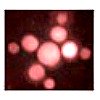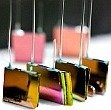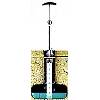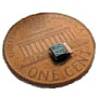Solar Power Technology

A new solar power technology promises to power planes, trains and automobiles with paint.
In fact, anything that has exposure to sunlight could be painted for power - fences, walls, rooftops ...even smartphones.
The secret is a paint-on, quantum-dot solar cell technology.
The paint is loaded with quantum dots that are extremely small measuring only a few nanometres in diameter. A nanometre is a billionth of a metre or about ten thousand times thinner than a human hair.
These tiny dots can convert sunlight into electricity just like conventional solar cells but unlike traditional solar cells, the solar power cost of quantum dots is a lot cheaper.
A square meter of solar paint is about $15 versus $1000 for a comparable solar panel.
The cost of making conventional solar panels is a major deterrent in expanding our use of solar energy. Solar cells are expensive to manufacture because silicon crystals are grown in high heat furnaces, cooled, then cut into thin wafers in sterile environments.
Solar electricity currently accounts for less than 1% of our energy supply yet enough sunshine hits Earth in just one hour to fulfill our worldwide energy needs for an entire year.
The problem is that our technologies remain relatively inefficient in capturing, converting, and storing all this free sunshine.
 But Sargent believes that the low cost of solar paint will accelerate the use of solar energy.
But Sargent believes that the low cost of solar paint will accelerate the use of solar energy.
Covering 150,000 square kilometers of surfaces with solar paint, in theory, would supply the energy requirements for the entire planet. Yet solar paint only converts 6 percent of the sunshine received into electricity compared to 17 percent for conventional solar cells.
Sargent points out that five years ago solar paint had a 0 percent efficiency rate due to impurities obstructing the flow of electrons and the inability to convert infrared light into electricity.
According to Michael McGehee of Stanford University, a renowned expert in organic solar cells, a power conversion efficiency rate of 6% percent for quantum dots is a very impressive progression. "At 10 per cent you start to have something compelling," adds Sargent.
With innovations in solar power technology such as solar paint, scientists predict that our use of solar energy will continually increase until it eventually becomes our major source of electricity.
Source: news.utoronto.ca
Solar Power Technology

A new solar power technology could enable your mobile devices to be recharged from any source of heat.
Solar energy efficiency is effectively converting light (heat) into electricity.
But the sun isn't the only source of light.
A new photovoltaic energy-conversion material has been developed at MIT that generates electricity from heat without using the sun.
Thermophotovoltaic (TPV) energy conversion is the direct conversion of heat into electricity. Heat emits photons and a photovoltaic diode cell can absorb these radiated photons and convert them into an electric current.
Although this method of conversion isn't new, it wasn't efficient because photovoltaic diode cells would only absorb specific wavelengths of photons generated by a heat source. This meant that much of the heat was wasted for generating electric current.
But scientists at MIT’s Institute for Soldier Nanotechnologies have developed a thermophotovoltaic material with billions of nanoscale pits on it's surface that will absorb varying wavelengths of photons. This dramatically increases the efficiency of converting heat into electricity.
Engineers at MIT are currently developing a system where power for a device such as a smartphone could be recharged from heat. This would be done by attaching a tiny heat cartridge containing anything that generates heat.
According to Ivan Celanovic, a MIT research engineer, such a system would be three times more efficient than a lithium-ion battery of the same size and could power your smartphone for a whole week without being recharged.
 It's possible that these heat cartridges could eventually be powered by a radioisotope, which produces heat from radioactive decay for thirty years.
It's possible that these heat cartridges could eventually be powered by a radioisotope, which produces heat from radioactive decay for thirty years.
This would eliminate the need for batteries or rechargers because your cartridge would generate electricity for three decades before needing to be replaced.
Related Articles: Solar Power Technology, New Solar Technology
Source: web.mit.edu







